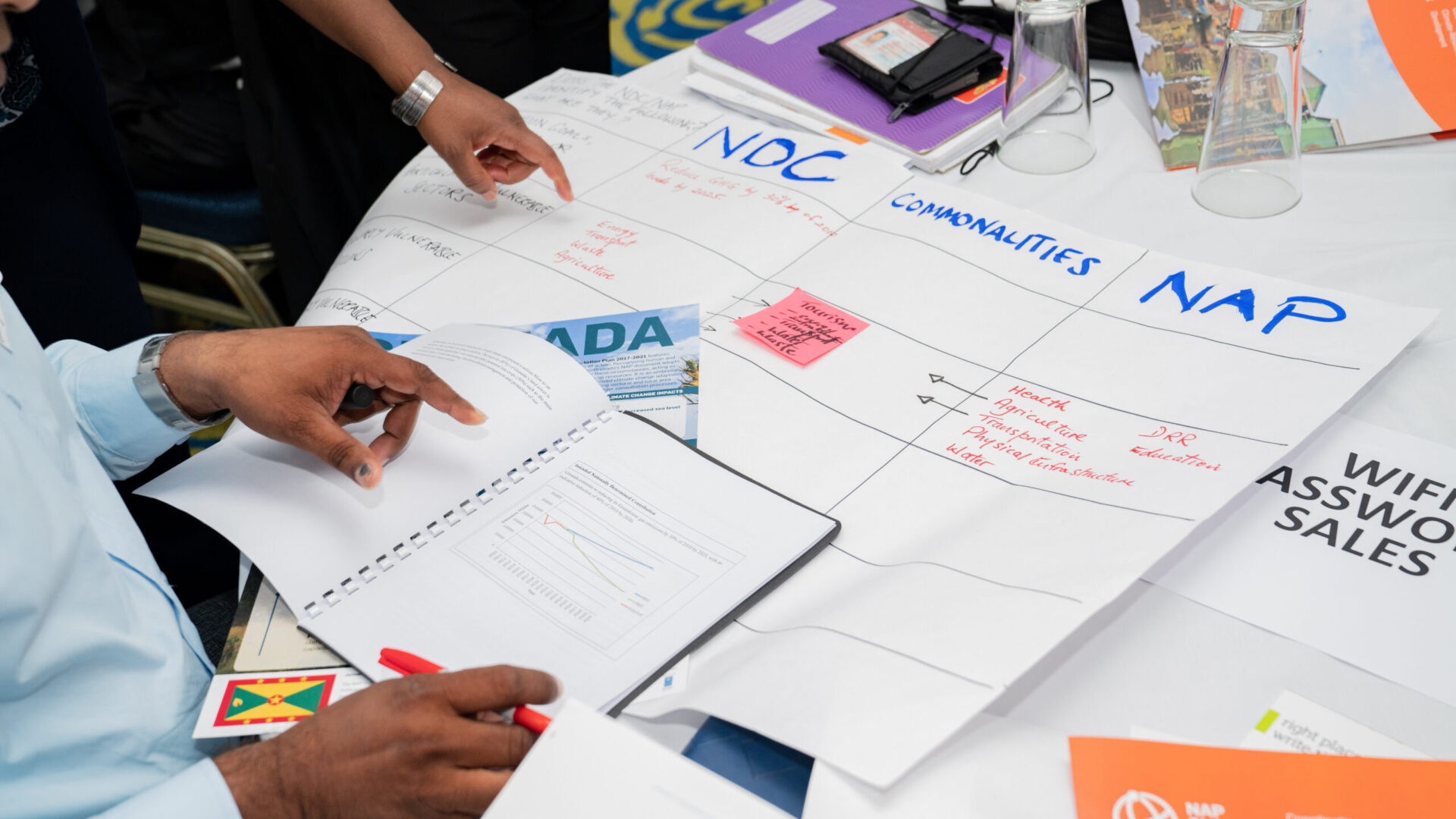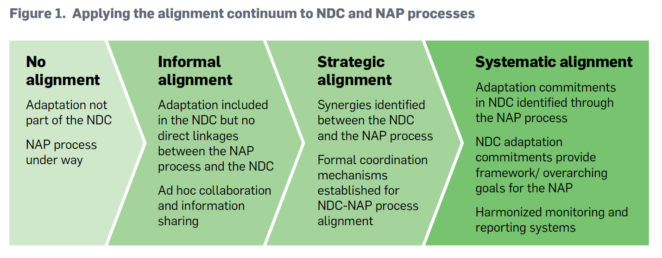Article /
Alignment to Advance Climate-Resilient Development | Country Perspectives on Alignment of the NAP Process and NDCs

Summary
This briefing note explores country perspectives on alignment of national-level policy processes under the Paris Agreement—specifically, the National Adaptation Plan (NAP) process and Nationally Determined Contributions (NDCs)—as a basis for broader alignment toward climate-resilient development. This is the third in a series of briefs focusing on alignment of country efforts under the 2030 Agenda for Sustainable Development, the Paris Agreement and the Sendai Framework for Disaster Risk Reduction.
*Download the full brief from the right-hand column. Overview Briefs 1 and 2 of this series are available to download below.
Read more in the “Alignment to Advance Climate-Resilient Development” series
Introduction
As countries advance policy processes related to the 2030 Agenda for Sustainable Development, the Paris Agreement and the Sendai Framework for Disaster Risk Reduction, there are considerable opportunities to pursue alignment, thereby increasing coherence, efficiency and effectiveness. This series of briefs aims to increase understanding of alignment at the country level, with previous briefs highlighting the benefits, different approaches and potential entry points for aligning different policy processes related to climate-resilient development.
The perspectives in this third brief are informed by dialogues with countries during a Peer Learning Summit with 16 countries in October 2018, as well as two national workshops in Grenada and Peru that explored alignment of the NDC and NAP processes in depth. During these events, country participants and representatives from international organizations explored the issue of alignment and exchanged knowledge and experiences across countries. They also worked together as country teams to reflect on their NDC and NAP processes, identifying concrete next steps they could take to increase alignment as the processes advance. In addition, this brief has been informed by a review of NAP documents and NDCs for all countries that have completed both documents and submitted them to the United Nations Framework Convention on Climate Change (UNFCCC).
Why Start With NDC and NAP Processes?
In the second brief in this series, it was noted that it may not be feasible or even desirable to align multiple policy processes at once in a particular country context (Dazé, Terton, & Maass, 2019). Given that the respective processes may involve different actors, operate on different timelines and have specific outputs, it may make sense to begin the alignment process by focusing on a limited number of policy processes.

For many countries, alignment of the NDC and NAP process represents a useful starting point, as both policy processes are linked to the Paris Agreement. In countries where adaptation information is included in the NDC, the two policy processes are interrelated. The NDC is a country’s pledge for meeting the goals of the Paris Agreement, including for adaptation. In contrast, the NAP process is a domestic planning process that allows countries to identify, address and review their adaptation needs while advancing implementation of adaptation measures. This makes these two processes complementary and creates entry points that countries can use to act on alignment in a number of ways:
- The NAP process can elaborate how adaptation commitments in the NDC will be achieved.
- The NDC can provide an overarching vision and framework for the NAP process.
- The NAP can provide an institutionalized and ongoing process through which the adaptation-related component(s) of successive NDCs can be identified and implemented.
- For countries that have not included an adaptation component in their NDC or that are planning to develop their adaptation contributions further in future years, the NAP process and its results could be used to inform the development of future NDCs.
- If well integrated with national sustainable development planning, the NAP process can help align the NDC to broader sustainable development objectives.
- The NDC could help to raise the profile of the NAP and leverage international support for finance, technology and capacity building for adaptation.
- The use of common objectives, data sets, socioeconomic analyses, climate models, risk assessment and vulnerability frameworks, and indicators by the NDC and the NAP could create efficiencies and coherence along with effectiveness for design and implementation.
Key Messages
- Alignment of the NDC and NAP process under the Paris Agreement may represent a feasible starting point in many countries and can provide a strong foundation for alignment with other agendas.
- The NDC and NAP can be complementary and mutually supportive. In general, the NDC provides high-level direction and principles for climate action, while NAP processes elaborate adaptation options and strategies for implementation.
- Dialogue with countries highlighted both challenges and opportunities related to alignment of the NDC and NAP process.
- Many countries aspire to increase the alignment between the NAP process and their NDC and are able to identify concrete actions that can be taken to achieve this.
- Key actions toward alignment include using the NAP process to (1) inform the development of future NDCs, (2) improve the quality of the adaptation-related information and (3) add value and enhance a country’s adaptation goal.
Suggested Citation
Dazé, A., Terton, A., and Maass, M. (2019) Alignment to Advance Climate-Resilient Development: Country Perspectives on Alignment of the NAP process and NDCs. NAP Global Network Overview Brief. IISD: Winnipeg, Canada.
References / Further Reading
Dazé, A., Terton, A., & Maass, M. (2018). Alignment to advance climate-resilient development – Overview Brief 1: Introduction to alignment. Retrieved from http://napglobalnetwork.org/resource/alignment-to-advance-climate-resilient-development-2/
Dazé, A., Terton, A., & Maass, M. (2019). Alignment to advance climate-resilient development – Overview Brief 2: Getting started on alignment. Retrieved from http://napglobalnetwork.org/resource/alignment-to-advance-climate-resilient-development/
Least Developed Countries Expert Group (LEG). (2018). National Adaptation Plans 2018. Progress in the process to formulate and implement national Adaptation Plans. Retrieved from https://unfccc.int/sites/default/files/resource/Progress%20in%20the%20process%20to%20formulate%20and%20implement%20 NAPs.pdf
Adaptation Community. (2017). NAP & NDC – Tool for Assessing Adaptation in the NDCs (TAAN): Quick facts. Retrieved from http://www.adaptationcommunity.net/nap-ndc/tool-assessing-adaptation-ndcs-taan/taan/
Bradley, R. & Hammill, A. (2017). Shared learning can align NDCs, NAPs, and SDGs to expand climate resiliency. NDC Partnership. Retrieved from http://ndcpartnership.org/news-and-events/news/sharedlearning-can-align-ndcs-naps-and-sdgs-expand-climate-resiliency
